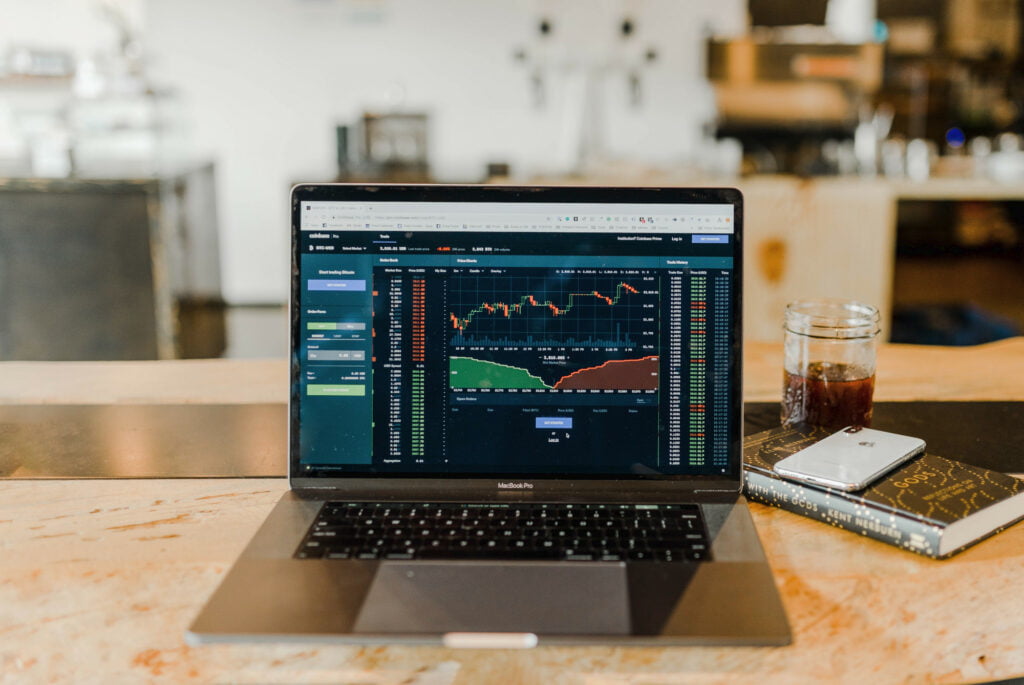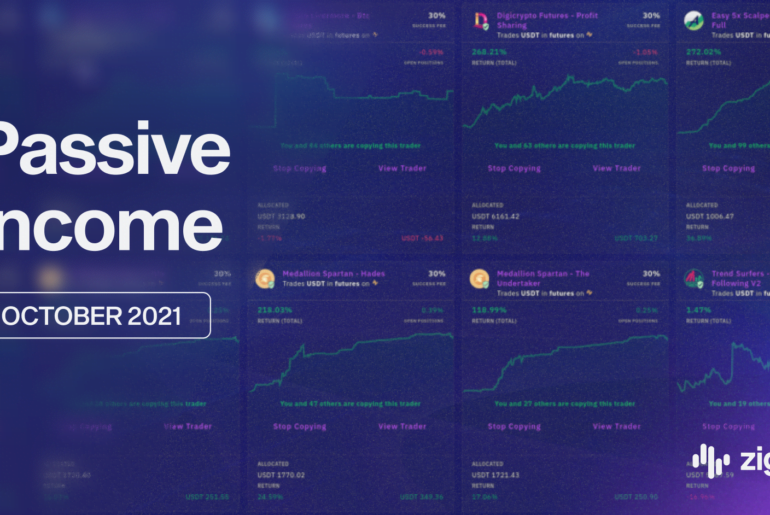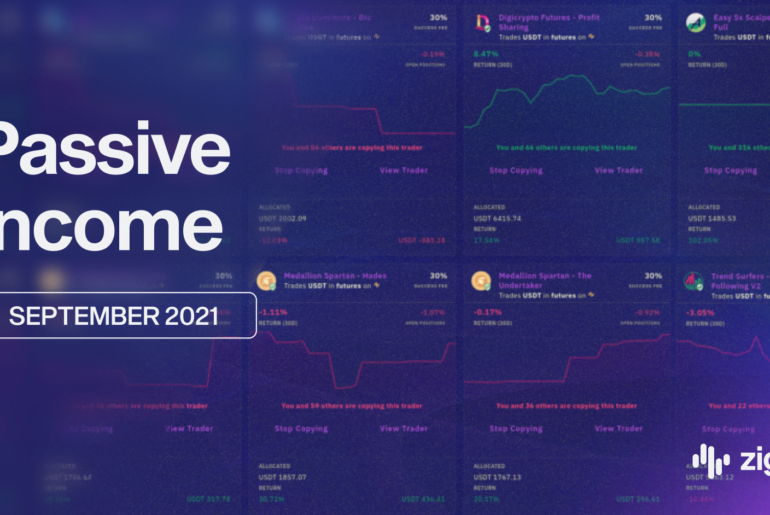Unlike, say medicine or sports, cryptocurrency trading is one of those jobs that everyone secretly believes they can do. After all, from an outsider’s perspective, there appears to be little difference between betting on financial assets and betting on horses. In each case, fate appears to dictate who the winners and losers are, and there is precious little than people can do to determine the outcome or predict the future.
<figcaption>Image from the Tradecity website</figcaption>This explains why so many people lose money trading. In the competitive area of day trading especially (we’ll go over this term in more detail later on), statistics show that only about 1.6% of all traders are consistently profitable, meaning that the vast majority of people don’t know how to trade cryptocurrency, and are there just to supply funds to those who actually know what they’re doing.
But what if there was a way that you could join this exclusive club? One that doesn’t involve investing in an expensive degree or shilling out cash to some Svengali who promises to show you the way only to leave you in the dust once the going gets rough? As is the case with all things worth doing, there is no silver bullet when it comes to crypto trading. But people do manage to master it enough to become consistently profitable, and some even go on to make a living out of it. Read on to find out how you can take your first steps at becoming one of them.
What is Trading and How Crypto Stands Out
In basic terms, trading usually means investing in a financial instrument and then selling that instrument at a higher price. Before the advent of cryptocurrencies, your investment options were limited to traditional assets such as stocks, bonds, commodities , and derivatives. The great thing about trading, however, is that no matter what market you’re trading in, the basic rules and patterns are the same. That’s because trading is, at heart, a profoundly human activity (bots are a big part of it these days, but even they are programmed by humans), which means that it is primarily governed by human emotions.
The big difference between day trading cryptocurrencies such as Bitcoin and Ether versus other markets lies in accessibility. Whereas to access traditional markets you typically need the aid of a broker or an institution, trading cryptocurrencies online is easy for anyone with a basic understanding of how computers work. On the other hand, traditional markets tend to have more checks and balances – your funds can be totally or partially guaranteed by a third party, the markets you’re trading are considerably more transparent and the risks of scams less prevalent. But the potential for profit is also much greater in the cryptosphere. In 2017 alone, multiple crypto assets provided dizzying returns, sometimes doubling or even tripling in value over the course of a few weeks. This makes crypto the ideal market for anyone with a high appetite for risk. Even if you have few funds at your disposal to start with, you can net insane profits as long as you understand the potential pitfalls.
Types of Trading
Just like other types of trading, cryptocurrency trading can broadly be categorized into three main types:
1. Day trading
Probably the most common form of trading in traditional markets, day trading involves the buying and selling of assets within a single day, with no positions held overnight. The benefits here are obvious – no losing sleep over risky trades, less chance of being impacted by a black swan event, and the ability to handle all your trades during working hours, leaving plenty of time for rest and relaxation afterward. The downside lies in the fact that you have to hunt for good set-ups day in and day out, and that you may very well miss out on big moves or larger time frame changes.
Day trading cryptocurrencies is possible thanks to the market’s characteristic wild swings in price, and using leverage to maximize your profits is commonplace. But it takes considerable discipline and knowledge to time the market just right, and you might find that by forcing the issue you end up missing the forest for the trees.
2. Swing trading
As its name suggests, swing trading is all about catching the swings in price. This usually happens on a larger time frame (usually several days up to a week). Anyone who’s ever looked at a chart knows that prices tend to move in waves. Getting in at the start of such a wave requires great precision, but it often results in excellent risk-to-reward ratios. The best part about swing trading is that it affords you the chance to reap good profits without having to babysit every single trade.
In the crypto-sphere, swing traders usually focus on large-cap coins such as Bitcoin, which are less prone to suddenly collapsing due to external factors and market manipulation. It’s important to note that catching the exact bottom for longing opportunities or the precise peak for shorting opportunities is not necessary. Even if you lose 10% here and there, anticipating the correct move will still net you considerable profits.
3. Position trading
While exact definitions differs, position trading typically refers to the holding of positions for larger amounts of time. Depending on the market you’re in, this can mean anywhere from several weeks to months and even years. The exact timing of when a bull market stops and a bear market begins can be difficult to identify, but a position trader is not looking for perfection, he or she is merely seeking to gain the most profit with the least amount of micromanaging.
Luckily, the crypto space is perfect for position trading. Many people who have bought and held Bitcoin and other assets for longer periods of time have typically reported substantial gains. It must be noted, however, that position trading is not the best way to maximize your profits in the short term. Rather, it involves playing the long game and discarding noise in favor of long-term potential. Still, it should not be confused with holding for life. A good position trader still plays the bull-and-bear cycle to the best of his abilities, protecting profits and knowing when to get out once the balance shifts.
Which Exchanges to Use?
No matter which trading strategy you end up going for, the next step involves creating an account on one of the online crypto exchanges currently available. Right from the get-go, you should know that not all exchanges cater to every jurisdiction. Bitmex, for instance, the largest cryptocurrency derivative platform, is not officially open to US customers, and even other exchanges such as Binance and Bittrex severely limit the number of coins you can transact depending on your place of origin. That said, here are the top contenders listed with their respective pros and cons:
● Coinbase
Pros: Accredited for US investors, large volume, has a good track record.
Cons: Not that many tradeable coins, no margin trading as of yet, slow to add new instruments and assets.
● Binance
Pros: Huge number of coins, numerous promotions and trading competitions, low fees.
Cons: limited funding-with-fiat options, can be complicated to use for beginners.
● Bitmex
Pros: diverse derivative offerings, generous leverage options, anonymity, available testnet.
Cons: no fiat funding, prone to blackouts and slow-downs during high volatility times, beginners need to exercise caution before playing with margin trading.
● Bitfinex
Pros: deep liquidity, advanced customization and trading options for experienced traders.
Cons: potentially-toxic association with Tether stable-coin (USDT), relatively slow deposits and withdrawals, mediocre customer service.
● Gemini
Pros: fully regulated and certified for US users, customers are eligible for insurance coverage.
Cons: relatively high fees, very few available trading pairs, not available to non-US traders.
● Kraken
Pros: US-based, never been hacked, accepts wire transfers for several currencies including EUR, GBP , and USD.
Cons: still a pretty slow platform despite recent improvements, much verification needed before users can transact large amounts.
As you can see, there are many options to choose from when it comes to trading cryptocurrencies. In fact, the ones we’ve listed above only scratch the surface of what’s available out there. As a general rule of thumb, however, newbie traders should steer clear of disreputable exchanges and carefully weigh their options before wiring money or placing any orders.
Common Crypto Trading Mistakes to Avoid
It’s often said that you need to learn how to walk before you can run. Well, when it comes to day trading cryptocurrency, it’s essential that you grasp what NOT to do first before you start working on any functional trading strategy. Despite seeming obvious in retrospect, you’d be surprised how many traders (even the ones that go on to become successful) make tremendous blunders when starting out. With that in mind, here are some of the most common mistakes that can pummel your portfolio in no time:
1. Putting more money in than you can afford to lose
With Bitcoin barely being 10 years old, the crypto markets are fairly new as far as financial instruments go. Not having the track record of stocks, bonds , and other commodities means that cryptocurrency trading is a much riskier proposition overall. While this shouldn’t dissuade you from participating in what may very well be one of the biggest opportunities for personal enrichment you’ll ever encounter, it should make you very aware of how truly uncharted this new territory is.
For this reason, never invest more than you can afford to lose. This means no maxing out credit cards, no taking a loan to finance your crypto investments and definitely no sacrificing your safety net for quick gains. Instead, take advantage of crypto’s massive profit potential to turn even small sums of money into larger ones gradually and without unnecessary risk.
2. Not practicing proper security
Probably the biggest roadblock to continued adoption for cryptocurrencies lies in their unorthodox nature. Due to basically being a series of digital assets with no real backing in the real world, cryptocurrencies are subjected to numerous threats each 24/7. An estimated $356 million worth of crypto has been stolen just in the first three months of 2019, either via phishing scams, exchange hacks or other unsavory practices. And as long as people don’t take the necessary steps to safeguard their funds, this trend looks set to continue.
The good part about crypto and Bitcoin in particular is that it is actually impervious to theft. As long as you and only you own the keys to your wallet, nobody can take your coins. But many people forego this element of security in favor of convenience, often storing their entire portfolio on online exchanges which are always susceptible to hacks and , in particular, exit scams. A good principle would be to only keep as much on an exchange as you’re willing to actively trade. Everything else should be safeguarded with a hardware wallet such as Trezor or Ledger, both of which are streamlined enough to be usable by newbie traders and experienced ones alike.
3. Listening to “experts” instead of forming your own strategy
Whether we’re talking Youtube, Telegram or Twitter, the crypto-space is awash with so-called “trading experts“, people who claim to be able to tell where the price is going at any given moment and are perfectly happy to share their findings with you, oftentimes for a sizeable fee. But while learning from others is essential on your road to mastering crypto trading, becoming over-reliant on anyone else’s opinion is a sure way to crater your portfolio.
That’s because the process of becoming a good trader involves learning how to do your own research and growing comfortable with your positions. Sometimes this will result in losses, but this is the price you’ll have to pay in order to get good. On the other hand, simply following someone else’s advice completely divorces you from the consequences of your own actions, never allowing you to build up the confidence you need to actually become proficient.
Anyway, for sure you can get advance from crypto signals, but this will only allow you to grow your assets or get profit, never to learn. So it’s always up to you what is your main goal.
4. Letting emotions interfere with your trading
If you spend any time whatsoever studying the intricacies of trading, you’ll quickly learn that most human actions in this area are governed by two basic emotions: fear and greed. The first one prevents you from taking action at the right time, while the latter keeps you in bad situations with the misguided goal of making an ever-increasing amount of money.
Both emotions are normal – after all, no one likes to lose money and making it can surely be addictive – but letting your actions be governed solely by emotions will ultimately prove unprofitable over the long-term. The key here is moderation – practice being content with whatever profits you’re reaping, and never engage in “revenge-trading” to make-up for your losses.
A way to avoid emotion-based mistakes is the use of automation and platforms like Zignaly, where you can set your entire strategy and rules. You can test and improve your strategy getting the emotions outside the equation.
5. Not understanding what makes the crypto space unique
Finally, a word needs to be said about the differences between crypto trading and traditional markets. While we’ve mentioned several times just how similar trading is regardless of the market you’re operating in, it would be a mistake to assume that this relatively new asset classes are identical to the ones that have come before it.
For one, crypto trading is a mostly unregulated field with relatively low liquidity, so the prevalence of pump-and-dump schemes is much more prominent. Secondly, some truths that apply to traditional markets don’t necessarily hold water here. For instance, the old axiom about never putting all your eggs in one basket (aka diversifying your portfolio) can quickly damage prove faulty in crypto, as pretty much all coins are subjected to the whims of Bitcoin. Therefore, it’s generally regarded as good practice to put a substantial amount of your investment in the original cryptocurrency, and save the rest for timely positions in other cresting assets. Last but not least, the sheer unpredictability of the crypto-space makes it imperative that you never go too long without checking your positions. That means no buying and forgetting about your coins for months at a time unless you want to have a heart attack when you open your wallet.https://www.youtube.com/embed/GyV1O-0JLkQ?feature=oembed
Conclusion
All things considered, the current crypto boom that started in 2017 shows no signs of slowing down anytime soon. While 2018 was a down year across the board, 2019 has been immensely promising so far, thus making it an excellent point to get in the game if you haven’t already.






